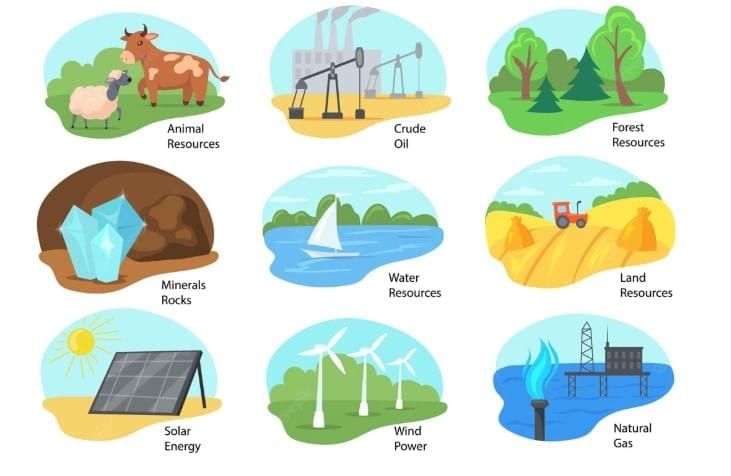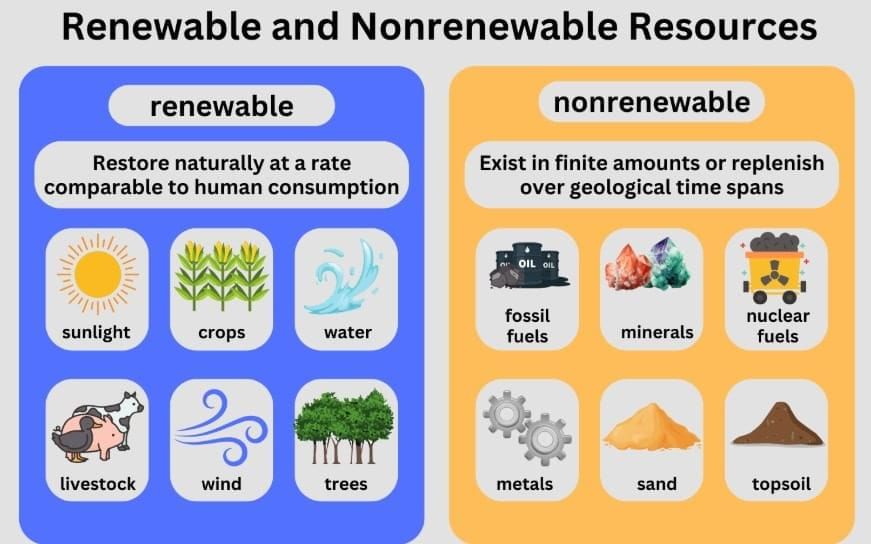Short and Long Answer Questions: Natural Resources and Their Use | Social Science Class 8 - New NCERT PDF Download
Short Answer Type Questions
Q1. Explain the terms resource conservation and sustainable development.
Ans:
- Resource conservation involves using resources thoughtfully to prevent their rapid depletion. It aims to ensure availability for future generations by maintaining a balance between our needs and resource preservation.
- This approach aligns with sustainable development, where resources are utilized to meet present needs without compromising the ability of future generations to meet their own needs.
 Natural Resources
Natural Resources
Q2. Why are human beings resources?
Ans: Human beings possess intelligence, which allows them to recognize the value of substances and their utility. Without humans, resources wouldn't hold significance. Interdependence among humans showcases their usefulness to each other, as seen with roles like postmen providing essential services.
For example, a postman renders us an important service, so he is a resource.
Q3. Write a short note on the significance of time and technology in making a substance a resource.
Ans: Time and technology are important factors in making substances resources. With time, technology develops. As technology develops, we begin to discover new ways to make life better. In this process, certain substances which were useless to us earlier become useful. Invention and discovery give us new resources. An example is hydroelectricity. This technology has made water a source of electricity.
Q4. As human beings, how can we ensure sustainable development?
Ans: Since we live on the earth, it is our duty to practice sustainable development. We can do this by ensuring that:
- The usage of renewable resources is sustainable
- The diversity of life on earth is maintained
- The damage caused to nature by our activities is as low as possible.
Q5. How does the uneven distribution of natural resources influence human activities?
Ans: The uneven distribution of natural resources shapes human settlements, trade patterns, economic activities, and international relations. Resource-rich areas attract industries, creating jobs and economic opportunities, but may also lead to displacement of local communities or conflicts over resource control, such as disputes over river water sharing (e.g., Kaveri River among Karnataka, Tamil Nadu, Kerala, and Puducherry).
Q6. What is the ‘natural resource curse,’ and how has India addressed it?
Ans: The ‘natural resource curse’ refers to the phenomenon where regions rich in natural resources experience slower economic growth due to an inability to develop industries that add value to these resources. India has generally avoided this by investing in industries to process resources like coal and minerals, meeting growing energy and development needs, though challenges in balancing extraction with sustainability remain.
Q7. Why is it important to maintain the natural rhythm of restoration and regeneration for renewable resources?
Ans: Maintaining the natural rhythm of restoration and regeneration ensures renewable resources, like forests, rivers, and soil, remain sustainable. Overexploitation, such as harvesting timber faster than forests can regrow or over-extracting groundwater, disrupts these cycles, leading to depletion, environmental degradation, and challenges like water scarcity or soil degradation.
Long Answer Type Questions
Q1. Describe how Natural Resources are classified.
Ans: Natural resources are classified based on their use and renewability.

Based on Use:
- Essential for life – Resources like air, water, and soil that are necessary for survival.
- Materials – Things used to make goods, such as wood for furniture or marble for buildings.
- Energy – Resources that provide power, like coal, solar energy, and wind.
Based on Renewability:
- Renewable resources – These can be naturally replaced if used carefully (e.g., sunlight, timber, river water).
- Non-renewable resources – These take millions of years to form and are limited in supply (e.g., coal, petroleum, iron).
Based on Origin (Living or Non-living):
- Biotic resources – Living resources like forests, animals, and fish.
- Abiotic resources – Non-living resources like minerals, metals, and water.
Q2. What is one environmental impact of cement production, and how is it being addressed?
Ans: Cement production releases fine dust into the air, which settles on soil and plants. This reduces crop yield by blocking sunlight needed for photosynthesis, lowers soil fertility, and causes respiratory problems in humans and animals.
To address this problem:
- Alternative materials such as mud-based construction and recycled materials are being encouraged to reduce cement use.
- Modern technologies like dust collection systems and pollution-control devices are installed in cement plants to capture dust and minimize emissions.
These measures help make construction more sustainable and environmentally friendly.
Q3. Explain the difference between renewable and non-renewable resources with examples from India, and discuss how their management affects sustainability.
Ans:
- Renewable resources, like solar energy, wind, river water, and timber from forests, can replenish naturally over time if managed sustainably, ensuring their availability for future generations. For example, India’s abundant sunshine powers solar projects like the Bhadla Solar Park.
- Non-renewable resources, such as coal, petroleum, and minerals like iron and copper, form over millions of years and cannot be replenished at the rate of use. India’s coal reserves, for instance, may last only another 50 years at current consumption rates.
- Sustainable management of renewable resources involves respecting natural cycles (e.g., not overharvesting timber), while non-renewable resources require judicious use and a transition to renewable alternatives to extend their availability and reduce environmental harm.
Q4. Describe the environmental and social impacts of overexploiting groundwater, using the Punjab case as an example.
Ans: Overexploitation of groundwater in Punjab, driven by the Green Revolution’s shift to water-intensive crops like wheat and paddy, has led to severe depletion, with 80% of the state’s groundwater classified as overexploited.
- Water tables have dropped to depths of about 30 meters, increasing extraction costs and risking long-term unavailability. Chemical fertilizers and pesticides used in modern farming have contaminated groundwater, causing health hazards.
- Socially, this threatens farmers’ livelihoods and food security, as seen in Punjab’s struggle to sustain its agricultural productivity. Initiatives like water harvesting, pond rejuvenation, and reduced water waste are being implemented to restore groundwater levels, but recovery is slow.
Q5. How has Sikkim’s transition to organic farming demonstrated the benefits of sustainable resource use?
Ans: Sikkim’s transition to 100% organic farming by 2016 involved switching to compost, natural pest repellents (e.g., neem and garlic), and multi-cropping, replacing chemical-intensive practices.
- Despite initial yield drops, after five years, farms thrived, producing high-value crops like cardamom and ginger. This shift increased farmers’ incomes by 20% on average, boosted biodiversity with the return of beneficial insects and birds, and attracted tourism due to its sustainable model.
- Sikkim’s success shows how sustainable practices can enhance ecological health, economic outcomes, and serve as a global model for organic farming.
|
31 videos|128 docs|7 tests
|
FAQs on Short and Long Answer Questions: Natural Resources and Their Use - Social Science Class 8 - New NCERT
| 1. What are natural resources and how are they classified? |  |
| 2. Why is the sustainable use of natural resources important? |  |
| 3. How do human activities impact natural resources? |  |
| 4. What are some examples of renewable and non-renewable resources? |  |
| 5. How can individuals contribute to the conservation of natural resources? |  |





















